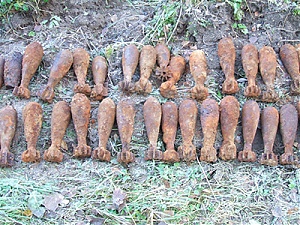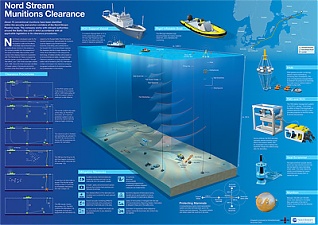Baltic States – CIS, Energy, EU – Baltic States, Gas, Transport
International Internet Magazine. Baltic States news & analytics
Sunday, 03.08.2025, 08:34
Company “BACTEC” attacks mines in Baltic Sea
 Print version
Print versionFrom the official Press Release of the Ministry of Defence of Latvia, March, 19, 2010:
«During the MCOPLAT mine clearance operation performed in the territorial waters of Latvia, 95 explosive subjects have been cleared.
13 bottom mines, two torpedos and 80 anchor mines have been identified. In total, 629 explosive subjects have been identified and cleared in the Irben Strait and Gulf of Riga since 1996.
During the MCOPLAT 2009 exercises the territory occupying 55 square sea-miles was cleared from unexploded ordnance by navies. In the time period of 13 years, between 1996 and 2009, the territory occupying more than 230 square sea-miles was cleared from mines and torpedos.
These short sentences of the official statement have told nothing about the courage and high professionalism of warships crew skillfully clearing the bottom of the Baltic Sea from mines.
The underwater ordnance clearance procedures are rather uniform and consist of several steps: the searching and identifying of the explosive subjects, the classification of identified subject, taking of a decision on the clearance of the explosive subject, the delivery of the blast by the autonomous underwater device or by the diver, the demolition of the charge.
Work for 800 years
 |
|---|
| The minomyotnye mines of the Second World War found the Latvian sappers. A photo of Latvian Zemessardze. |
The weight of demolition charges may be different and goes up to 50 kg. The demolition of an old mine, which has lied on a seabed for 65 to 95 years, is a rather difficult task. If a mine is lying on a seabed it must be filled with water. The explosive material TNT or RDX immersed in water for a time period of several decades loses more than 90% of its capacity. The weight of the sea-mine’s combat charge may reach 300 kg and if there are only 30 kg remained this is enough to bring some trouble. (TNT charge of 200 g only will completely destroy a car).
The bottom mines with charge’s weight up to 800 kg are much more dangerous because their watertight casings ensure that charges can remain dry for many decades.
The second factor, which must be taken in to account when the condition of an old mine is evaluated, is the detonator’s condition. Mine clock mechanisms, lag, magnetic and acoustic fuses become completely rusty during half a century. The only exception is the “Herc’s Horns” because their glass ampoules filled with the “Grene liquid” when broken will generate electricity even after a hundred years. Herc’s mines of 1877 design, crops of which are made of galvanized steel, could be the most dangerous naval weapon even today, if these mines would not be filled with moisture-sensitive piroxylin.
In order to initiate the detonation of an old mine lying on the seabed a rather powerful external charge must be applied. It can be assumed that during the MCOPLAT exercises in 2009 4750 kg of explosives (95x50kg) were spent by navies for the demolition of 95 explosive subjects. Moreover, it must be taken in to account that some mines does not detonate after the first explosion and the demolition procedure should be repeated.
There is a certain number of destructive effects, which characterize the underwater explosion, there are factors affecting the environment, too. The underwater explosion causes the fish kill, the destruction of sea-bottom fauna and plankton, the formation of craters on the seabed, the probable intoxication of the considerable amount of water with explosion products.
However during the mine-clearance operations performed by navies of Baltic Sea States the protection of the environment is not a priority. Navies primarily serve the law requiring them to ensure the navigation safety.
Navies of Baltic Sea States annually find and destroy dozens of mines spending tons of explosives. If it is taken into account that there are more than 80 000 mines (according to German data about 150 000 explosive subjects) lying on a seabed, navies will finish their mine-clearance operations after 800 years. And what will happen with the Baltic Sea if all 80 000 mines will be detonated ..?
The Highest Standard
 |
|---|
| The Scheme of forces and means of the mines involved at destruction on technology of Company BACTEC. The scheme from a site nord-stream. |
However the situation with the environment protection is changing, when it comes to commercial construction at the bottom of the Baltic Sea. In this case governments of coastal countries may ask the contractor to comply with higher environment protection standards.
Under these conditions the Nord Stream Company is extremely careful about all concerning the environment protection. The impact of the pipeline on the environment has been carefully studied paying a particular attention to the ordnance-clearing within the pipeline construction corridor.
It is impossible to detonate an underwater mine without a considerable impact on the environment. One of the main Nord Stream Company aims is the minimization of this impact and the using of environmentally friendly technologies. After some searching and research the partner, which is capable to perform the mine-clearance operations causing a minimal impact to the environment, was found. This particular partner is the British Company BACTEC International Limited.
Checked. No Mines.
There are a lot of sites on our Planet where wars and military conflicts took place during the last hundred years. According to the UN data there are more than 70 states which need to clear their territory of mines, bombs, shells and other explosive subjects.
In all countries the mine-clearance operations are usually performed by military specialists. However the amount of work on the elimination of the mine riskiness is so great that often there is necessity to involve in mine-clearance operation private companies, too.
The Company BACTEC was established in 1991 to provide risk mitigation services for unexploded ordnance, land and sea mine clearance, supporting construction projects and worldwide explosive ordnance clearance initiatives.
BACTEC's aim is to reduce and eliminate the risk posed by the contamination caused by unexploded ordnance and land mines; to alleviate the impact that the contamination causes to infrastructure for future development, people's lives socially, economically and environmentally.
The Company Head Office is located in the City of Rochester, Kent, UK. BACTEC has offices/branches located in Australia, Laos, Mozambique, Libya, Lebanon and Cambodia. Since 1991 BACTEC has been directly involved with the clearance of more than 500,000 landmines and thousands of tons of unexploded ordnance; has cleared or verified in excess of 17,000,000 square meters of ordnance contaminated land across 40 countries.
BACTEC has developed specific underwater ordnance clearance services specifically for ports, docks and harbor developments, offshore and near shore structures and bridge abutments. Projects which may require Marine Services include windfarms, subsea cables, pipe laying projects, oil, gas and mineral exploration and capital dredging projects.
BACTEC is contracted to Nord Stream in mine-clearance activities providing the mine-clearance in the pipeline construction corridor in Finnish and Swedish waters.
The mine-clearance technique used by BACTEC differs from navy’s techniques described above. BACTEC performs the mine-clearing using the technique of directed cumulative explosions, as well as conducts environmental activities.
Questions and Answers
The Magazine BALTFORT has applied to BACTEC with request to provide answer to some questions Managing Director Mr. Kevin Kneebone kindly agreed to answer our question.
Question: Has the BACTEC Company a mine-clearance experience in other seas?
Answer: Yes, of course, BACTEC has performed mine-clearance operation in North Sea, English Chanel, in the Pacific and Red Sea.
Question: Does BACTEC use cumulative charges in mine-clearance operation within the Nord Stream pipeline construction corridor?
Answer: The system of precision cumulative explosions used by BACTEC in this project uses a set amount of explosive which is designed to penetrate the mine casing to initiate the main bulk explosive.
This system will be used for the demolition of all mines located in the BACTEC responsibility zone. The main rule executed by BACTEC – the amount of the explosive used for mines detonation should be minimal.
Question: Whether we understand correctly, how the cumulative charge will be applied (please see the sketch in the attachment)?
Answer: The basic idea in the drawing is correct.
Question: How many mines BACTEC has already cleared within the BACTEC responsibility zone?
Answer: To date over 10% of the mines have been cleared; BACTEC is currently on schedule for the project.
Question: Is there a possibility that some remains of cleared mines might be offered to museums?
Answer: This is unlikely as any debris recovered will not be recognizable to be identified as a sea mine.
The using of cumulative charges with minimal amount of the explosive is not the only mitigation procedure used by BACTEC in order to minimize the impact to the environment. The sonar survey to detect fish shoals and marine mammal is conducted prior any clearance operation; the high intensity ultrasound emitter frightens away inhabitants of the underwater world. The demolition of the sound cartridge conducted straight before the detonation of the cumulative charge in a moment frightens away fish shoals and seals.
When the mine-clearance operation is finished the site is monitored with ROV (remotely operated vehicle) in order to evaluate the operation results.
It is to be hoped that the advanced environmentally friendly technologies used by BACTEC in mine-clearance operations in the Baltic Sea would be applied by navies of Baltic Sea Countries, too.
Article has been published in the Baltic military-historical magazine BALTFORT № 1 (10) for 2010.








 «The Baltic Course» Is Sold and Stays in Business!
«The Baltic Course» Is Sold and Stays in Business!

